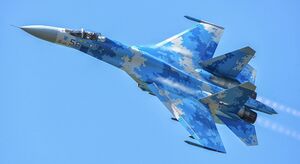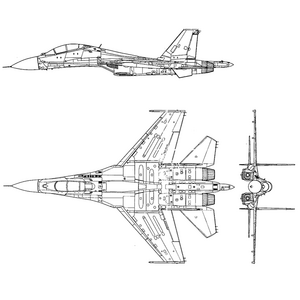NSF-12 Albatro Strike Fighter
| Casati NSF-12 Albatro | |
|---|---|

| |
| Painted in CRN Colors | |
| Role | Multirole fighter aircraft |
| National origin | |
| Manufacturer | Casati Aircraft Corporation |
| First flight | 15 March 1974 |
| Introduction | 16 April 1974 |
| Status | In active service |
| Primary user | |
| Produced | 1974—Present |
| Number built | 650 |
| Unit cost |
ɫ27,280,000
|
The Casati NSF-12 Albatro (Albatross) is a twin-engine all-weather supersonic carrier-capable jet fighter developed and produced by Casati Aircraft Corporation. It is a primary competitor to other modern fourth-generation fighters and is known for being one of the Royal Navy's first supermaneuverable aircraft. It was designed to fulfill a varying number of roles and is slated to be replaced by the NSF-13 Folgorazione and NSF-14 Colibri over the next decade.
Development
In the late 1960s, the Royal Navy found itself severely lacking of a modern-day carrier-based fighter craft. Fearing the possible serious technological disadvantage that the Royal Navy might experience against modern developments in Ossoria and Acrea, Grand Admiral Andrea Doria quickly approached military designers to begin working on a project to replace the Kingdom's aged fighters. While a large part of the actual design was accomplished by the Casati Aircraft Corporation, they were assisted in a number of electronic interfaces by Ersilia Defense and Aeronautics, who—at the time—were also working on a project for the Royal Air Fleet.
Although it took nearly two years longer than originally planned, the NSF-12—which had been designated Albatro—reached the prototype stage in 1972. Early tests were very promising and the NSF-12 entered full-scale production in 1974.
Production
The NSF-12 entered production in 1974 and was a primary product of aeronautical manufacturers for a good three years in order to replace the much older NSF-11. After a quota was met in 1979, the Albatro began entering reduced production which is expected to end by 2020.
Production Figures
A total of 650 NSF-12s were built to replace the NSF-11 as the Royal Navy's main fighter. However, following the introduction of its successors, only 350 remain in service with the remaining 300 awaiting disassembly.
Design
The NSF-12 shares several core design traits with the AFASF-12 Drago that was being developed around the same time by Ersilia D&A. Its swept wing blends into the aircraft's fuselage at the leading edge extensions, forming a cropped delta design. The NSF-12 is also characterized for being the Kingdom's first aircraft to utilize a fly-by-wire control system.
The Albatro is armed with a multipurpose 30 mm connon in the starboard wingroot and is equipped with ten hardpoints for missiles and various other weaponry. As a naval strike fighter, the NSF-12 is designed to carry armaments that would allow it to engage ships, ground targets, and other aircraft.
Operational History
The NSF-12 was deployed in support of Government loyalist and Cacertian intervention troops during the FedCom Civil War and saw limited combat in Nalaya during the Nalayan Civil War.
Specifications
General Characteristics
- Crew: 1
- Length: 21.9 m (72 ft 9 in)
- Wingspan: 14.7 m (48 ft 3 in)
- Height: 5.9 m (21 ft 1 in)
- Wing Area: 62.0 m² (667 ft²)
- Empty Weight: 16,380 kg (36,100 lbs)
- Loaded Weight: 23,430 kg (51,650 lbs)
- Max Takeoff Weight: 30,450 kg (67,100 lbs)
- Powerplant: 2 x Cas-NSF12-74 Turbofans
- Fuel Capacity: 9,400 kg (20,724 lbs)
Performance
- Maximum Speed: Mach 2.35 (2,500 km/h, 1,550 mph) at altitude
- Cruise Speed: 1,700 km/h (1,056 mph)
- Service Ceiling: 19,000 m (62,523 ft)
- Rate of Climb: 300 m/s (59,000 ft/min)
- Wing Loading: 371 kg/m² (76.0 lb/ft²)
- Thrust/Weight: 1.07
Armament
- Guns: 1 x 30 mm cannon with 150 rounds
- Payload: 4,430 kg (9,770 lb) on 10 external hardpoints (2 wingtip, 6 underwing, 2 underbelly)

